Finite-Element-Analysis-Based Study of a Failure Phenomenon in HDPE Pipes
Abstract
:1. Introduction
2. Models and Methods
2.1. Damage of HDPE Pipes
- Internal conditions (high pressure, rapid pressure variations, the temperature being too high or too low, and the type of liquid transported);
- Design, installation, or handling errors;
- Inappropriate material or material with initial defects;
- Geothermal activity (movement of the crust or seismic forces);
- Anthropogenic activity (heavy traffic, explosions, or other activities).
2.2. Experimental Methods for Determining the Mechanical Properties of the Material Used
- High-density polyethylene tube with dimensions of Φ63 × 4 mm;
- High-density polyethylene tube with dimensions of Φ90 × 6 mm.
- Distribution of the longitudinal modulus of elasticity;
- Distribution of stress at the maximum load, depending on the elongation at the maximum load;
- Force distribution at the maximum load, depending on the deformation at the maximum load;
- Distribution of the longitudinal modulus of elasticity, depending on tensile strength;
- Distribution of stiffness, depending on the force at the maximum load;
- Distribution of stress at maximum deformation, according to the elongation at maximum deformation;
- Distribution of the breaking force, depending on the breaking deformation;
- Distribution of the breaking stress, according to the breaking elongation.
- As the tube diameter increases, the standard deviation of the values increases;
- The values of Young’s modulus fell between 1500 and 4000 MPa for the high-density polyethylene samples taken from the 90 × 6 mm tube, and between 1000 and 1400 MPa for the high-density polyethylene samples taken from the 63 × 4 mm tube;
- The average stress at the maximum load, depending on the elongation at the maximum load, was around 20 MPa for both types of samples;
- The force at the maximum load for the high-density polyethylene cut from the 90 × 6 mm tube was between 1.2 kN and 1.6 kN, and for the case of the high-density polyethylene cut from the 63 × 4 mm tube, it was between 0.7 kN and 0.8 kN;
- The most important scattering of values was obtained for the distribution of the stress at the maximum deformation, according to the displacement at the maximum deformation for both types of specimens made of high-density polyethylene tubes.
3. Results
3.1. The Case of Elbow DN 315 Buried in Soil
3.2. FEM Analysis of the Pressurized HDPE-DN 315 Tube
- The pressure inside the tube, taken as the reference pressure perpendicular to the inner wall of the tube;
- The fixed ends of the tube and the forces that act on the tube, so that equilibrium is assured.
4. Discussion and Conclusions
Author Contributions
Funding
Informed Consent Statement
Data Availability Statement
Conflicts of Interest
References
- Scărlătescu, D.D.; Vlase, S.; Crișan, A.; Modrea, A. Traction Tests to determine the Behavior of the Materials sed in Water Supply Networks. Acta Tech. Napoc. Ser. Appl. Math. Mech. Eng. 2019, 62, 175–182. [Google Scholar]
- Vlase, S.; Scărlătescu, D.D.; Scutaru, M.L. Stress field in tubes made of high-density polyethylene used in water supply systems. Acta Tech. Napoc. Ser. Appl. Math. Mech. Eng. 2019, 62, 273–280. [Google Scholar]
- Vlase, S.; Scarlătescu, D.; Marin, M.; Öchsner, A. Finite element analysis of an elbow tube in concrete anchor used in water supply networks. Proc. Inst. Mech. Eng. Part L J. Mater. Des. Appl. 2019, 234, 3–11. [Google Scholar] [CrossRef]
- Scărlătescu, D.D.; Modrea, A.; Stanciu, M.D. Three-point Bend Test to Determine the Mechanical Behavior of the Tubes Used in Water Supply Networks. Procedia Manuf. 2019, 32, 179–186. [Google Scholar] [CrossRef]
- Modrea, A.; Hebert, H.; Scărlătescu, D.D. FEM Applied to Determine the Stress-strain Field in the Tubes of the Water Supply Networks. Procedia Manuf. 2019, 32, 187–193. [Google Scholar] [CrossRef]
- Vlase, S.; Marin, M.; Scutaru, M.L.; Scărlătescu, D.D.; Csatlos, C. Study on the Mechanical Responses of Plastic Pipes Made of High Density Polyethylene (HDPE) in Water Supply Network. Appl. Sci. 2020, 10, 1658. [Google Scholar] [CrossRef]
- Kubrak, M.; Malesińska, A.; Kodura, A.; Urbanowicz, K.; Bury, P.; Stosiak, M. Water Hammer Control Using Additional Branched HDPE Pipe. Energies 2021, 14, 8008. [Google Scholar] [CrossRef]
- Bouaziz, M.A.; Guidara, M.A.; Schmitt, C.; Hadj-Taïeb, E.; Azari, Z.; Dmytrakh, I. Structural integrity analysis of HDPE pipes for water supplying network. Fatigue Fract. Eng. Mater. Struct. 2019, 42, 792–804. [Google Scholar] [CrossRef]
- Kodura, A. Influence of Downstream Pipe Length on the Water Hammer Parameters in HDPE Pipelines. Ochr. Srodowiska 2018, 40, 15–20. [Google Scholar]
- Kim, J.; Lyons, R.; Cho, J.; Koo, D.D. Case Study: Challenges to Install Vertically Curved HDPE Casing Pipes for 36-Inch Large Diameter Water Mains Crossing Highway. In Pipelines 2017: Planning and Design, Proceedings of Sessions of the Pipelines 2017 Conference, Phoenix, AZ, USA, 6–9 August 2017; American Society of Civil Engineers: Reston, VA, USA, 2017; pp. 400–409. [Google Scholar] [CrossRef]
- Bordeasu, I.; Baciu, I.D. Applied Hydraulics; Politehnica Publishing House: Timisoara, Romania, 2002; ISBN 973-8109-90-6. [Google Scholar]
- Modrea, A.; Scărlătescu, D.D.; Gligor, A. Mechanical Behavior of the HDPE Tubes Used in Water Supply Networks Determined with the Four-Point Bending Test. In Proceedings of the 12th International Conference Interdisciplinarity in Engineering (INTER-ENG 2018), Procedia Manufacturing, Tirgu Mures, Romania, 4–5 October 2018; Volume 32, pp. 194–200. [Google Scholar] [CrossRef]
- Scutaru, M.L.; Teodorescu-Draghicescu, H.; Vlase, S.; Marin, M. Advanced HDPE with increased stiffness used for water supply networks. J. Optoelectron. Adv. Mater. 2015, 17, 484–488. [Google Scholar]
- Teodorescu-Draghicescu, H.; Vlase, S. Homogenization and averaging methods to predict elastic properties of pre-impregnated composite materials. Comput. Mater. Sci. 2011, 50, 1310–1314. [Google Scholar] [CrossRef]
- Li, Z.; Zhu, H.W.; Qiu, P.X.; Seibi, A. Analytical Method for Temperature Distribution in Buried HDPE Pipe. In Proceedings of the International Conference on Management, Manufacturing and Materials Engineering (ICMMM 2011), Zhengzhou, China, 8–10 December 2011; Volume 452–453, pp. 1205–1209. [Google Scholar] [CrossRef]
- Li, H.; Zhang, X.; Huang, H.; Zhou, T.; Qi, G.; Ding, H. Simulation Analysis of Limit Operating Specifications for Onshore Spoolable Reinforced Thermoplastic Pipes. Polymers 2021, 13, 3480. [Google Scholar] [CrossRef] [PubMed]
- Halabian, A.M.; Hokmabadi, T. A new hybrid model for rigorous analysis of buried pipelines under general faulting accounting for material and geometrical non-linearities with focusing on corrugated HDPE pipelines. Soil Dyn. Earthq. Eng. 2018, 115, 1–17. [Google Scholar] [CrossRef]
- Ocłoń, P.; Cisek, P.; Taler, D.; Pilarczyk, M.; Szwarc, T. Optimizing of the underground power cable bedding using momentum-type particle swarm optimization method. Energy 2015, 92, 230–239. [Google Scholar] [CrossRef]
- Rueda, F.; Marquez, A.; Otegui, J.; Frontini, P. Buckling collapse of HDPE liners: Experimental set-up and FEM simulations. Thin-Walled Struct. 2016, 109, 103–112. [Google Scholar] [CrossRef]
- Gao, Y.F.; Jin, S.; Cheng, P.; Han, P.H.; Bai, Y. Investigation on mechanical properties of fiberglass reinforced flexible pipes under bending. In Proceedings of the ASME International Conference on Ocean Offshore and Arctic Engineering (OMAE 2019), Glasgow, Scotland, 9–14 June 2019. [Google Scholar]
- Guidara, M.A.; Bouaziz, M.A.; Schmitt, C.; Capelle, J.; Hadj-Taieb, E.; Azari, Z.; Hariri, S. Burst Test and J-Integral Crack Growth Criterion in High Density Poly-Ethylene Pipe Subjected to Internal Pressure. In Proceedings of the 1st Conference on Multiphysics Modelling and Simulation for Systems Design (MMSSD), Sousse, Tunisia, 17–19 December 2014; Volume 2, pp. 391–399. [Google Scholar] [CrossRef]
- Ruan, W.; Qi, K.; Han, X.; Sun, B.; Gao, X.; Li, J. Multi-scale coupling numerical modeling of metallic strip flexible pipe during reel-lay process. Ocean Eng. 2023, 283, 115209. [Google Scholar] [CrossRef]
- Fredriksson, D.W.; DeCew, J.C.; Tsukrov, I. Development of structural modeling techniques for evaluating HDPE plastic net pens used in marine aquaculture. Ocean Eng. 2007, 34, 2124–2137. [Google Scholar] [CrossRef]
- Bouaziz, M.A.; Guidara, M.A.; Schmitt, C.; Capelle, J.; Taieb, E.H.; Azari, Z.; Hariri, S. Failure Analysis of HDPE Pipe for Drinking Water Distribution and Transmission. In Proceedings of the Design and Modeling of Mechanical Systems—II Lecture Notes in Mechanical Engineering Sixth Conference on Design and Modeling of Mechanical Systems (CMSM 2015), Hammamet, Tunisia, 23–25 March 2015; pp. 407–414. [Google Scholar] [CrossRef]
- Shi, J.; Miao, Y.Z.; Li, X.; Li, G.Z.; Wan, Y.; Lu, P.L. Investigation of Failure Behavior of Polyethylene Pipe Reinforced by Winding Steel Wires Subject to Inner Pressure and Bending. In Proceedings of the ASME 2020 Pressure Vessels and Piping Conference (PVP2020), Virtual, 3 August 2020; Volume 6. [Google Scholar]
- Daikh, A.; Aminallah, L.; Merdji, A.; Gaidi, L.; Alkhaldi, H.; Roy, S.; Msomi, V.; Mukdadi, O.M. Analysis of the harmfulness of the water hammer phenomenon in high density poly-ethylene (HDPE) pipes. Int. J. Press. Vessel. Pip. 2023, 204, 104963. [Google Scholar] [CrossRef]
- Xiong, H.C.; Bai, Y.; Qiao, H.D.; Ruan, W.D. Analysis on the mechanical properties of the plastic pipe reinforced by cross helically winding steel wires(PSP) under internal pressure. In Proceedings of the 34th ASME International Conference on Ocean, Offshore and Arctic Engineering (OMAE2015), St John’s, NL, Canada, 31 May–5 June 2015. [Google Scholar]
- Holder, S.L.; Hedenqvist, M.S.; Nilsson, F. Understanding and modelling the diffusion process of low molecular weight substances in polyethylene pipes. Water Res. 2019, 157, 301–309. [Google Scholar] [CrossRef]
- Sonkar, V.; Bhattacharya, S.; Sharma, K. Numerical Simulation of Three Dimensional Fracture Mechanics Problems of Functionally Graded Pipe and Pipe Bend Using XFEM. Iran. J. Sci. Technol. Trans. Mech. Eng. 2022, 46, 1031–1045. [Google Scholar] [CrossRef]
- Sim, J.M.; Chang, Y. Crack growth evaluation by XFEM for nuclear pipes considering thermal aging embrittlement effect. Fatigue Fract. Eng. Mater. Struct. 2019, 42, 775–791. [Google Scholar] [CrossRef]
- Lin, M.; Agbo, S.; Duan, D.-M.; Cheng, J.J.R.; Adeeb, S. Simulation of Crack Propagation in API 5L X52 Pressurized Pipes Using XFEM-Based Cohesive Segment Approach. J. Pipeline Syst. Eng. Pr. 2020, 11, 04020009. [Google Scholar] [CrossRef]
- Hammadi, N.; Mokhtari, M.; Benzaama, H.; Madani, K.; Brakna, A.; Abdelouahed, E. Using XFEM to Predict the Damage with Temperature of the Steel Pipe Elbows under Bending and Pressure loading. Frat. Ed Integrita Strutt.-Fract. Struct. Integr. 2020, 15, 345–359. [Google Scholar] [CrossRef]
- Salmi, H.; El Had, K.; El Bhilat, H.; Hachim, A. Numerical Analysis of the Effect of External Circumferential Elliptical Cracks in Transition Thickness Zone of Pressurized Pipes Using XFEM. J. Appl. Comput. Mech. 2019, 5, 861–874. [Google Scholar] [CrossRef]
- Khalaj, O.; Azizian, M.; Darabi, N.J.; Tafreshi, S.N.M.; Jirková, H. The role of expanded polystyrene and geocell in enhancing the behavior of buried HDPE pipes under trench loading using numerical analyses. Geosciences 2020, 10, 251. [Google Scholar] [CrossRef]
- Naeini, S.A.; Mahmoudi, E.; Shojaedin, M.M.; Misaghian, M. Mechanical response of buried High-Density Polyethylene pipelines under normal fault motions. KSCE J. Civ. Eng. 2016, 20, 2253–2261. [Google Scholar] [CrossRef]
- Benyerou, D.; Chikh, E.B.O.; Khellafi, H.; Meddah, H.M.; Benhamena, A.; Hachelaf, K.; Lounis, A. Parametric Study Of Friction Stir Spot Welding (FSSW) For Polymer Materials Case Of High Density Polyethylene Sheets: Experimental and Numerical Study. Frat. Ed Integrita Strutt. Fract. Struct. Integrity 2021, 15, 145–158. [Google Scholar] [CrossRef]
- Li, Z.; Tang, F.; Chen, Y.; Tang, Y.; Chen, G. Elastic Buckling of Thin-Walled Liners Encased in Partially Grouted Pipelines under External Pressure. J. Struct. Eng. 2020, 146, 04020042. [Google Scholar] [CrossRef]

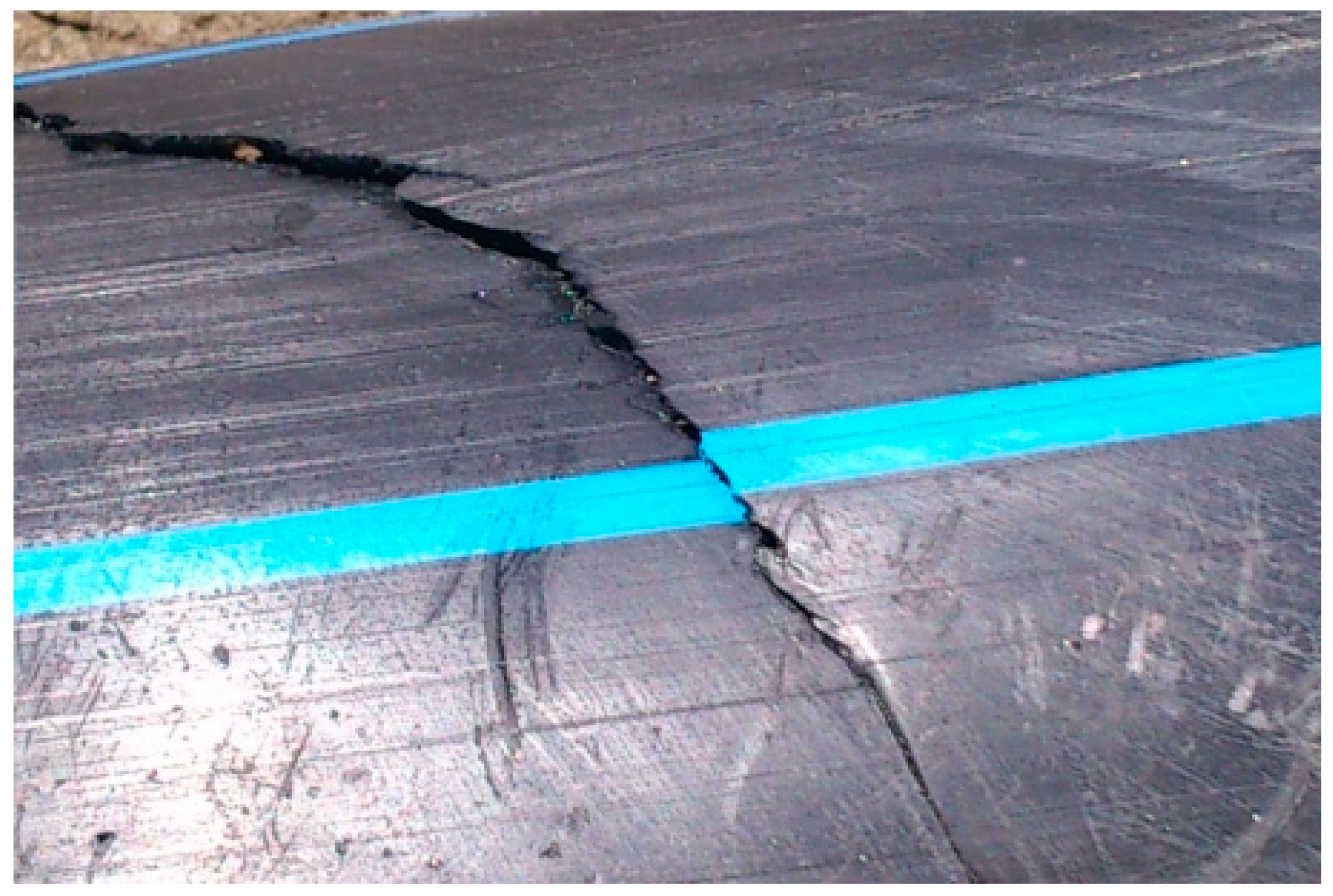
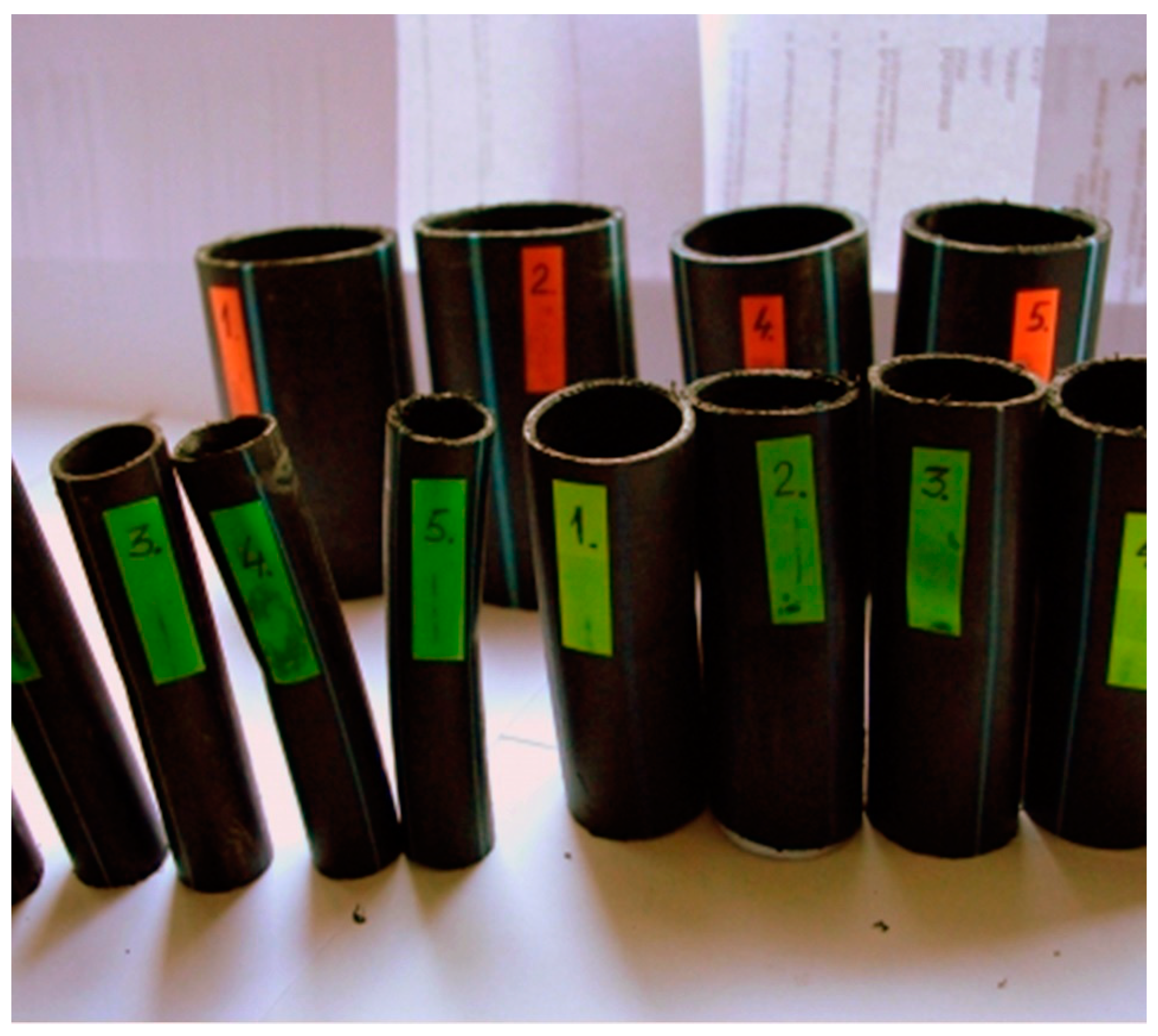
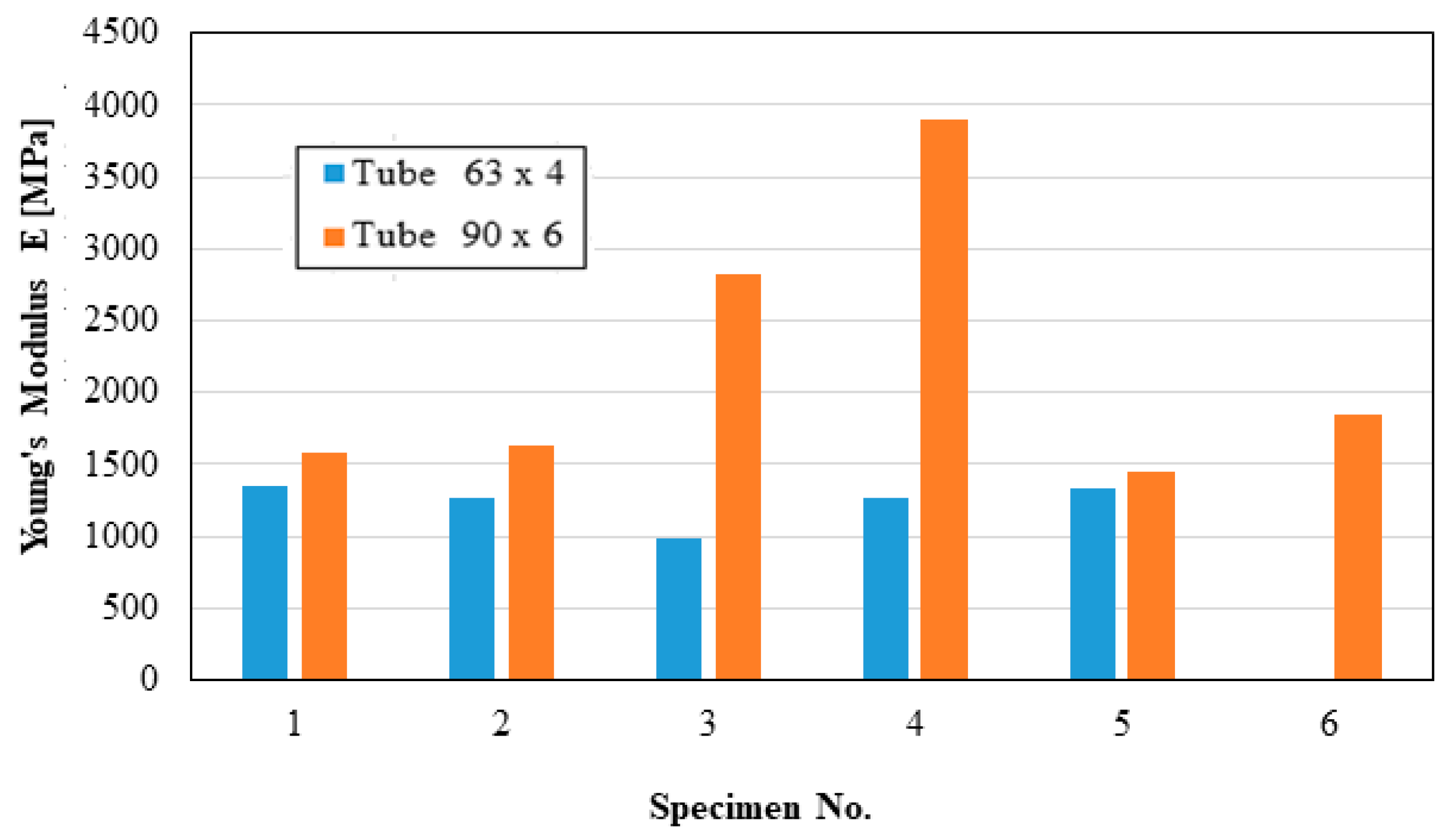
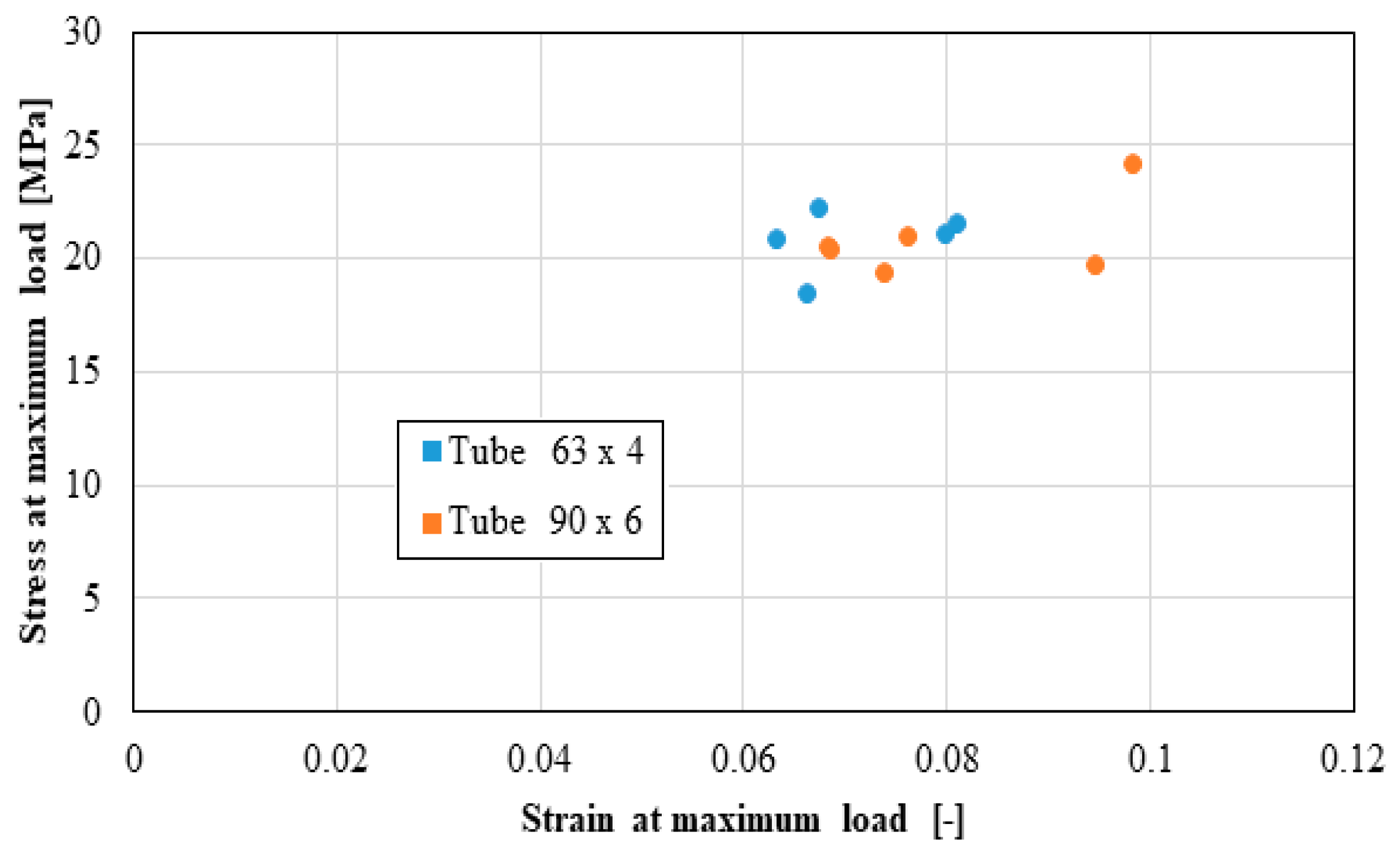
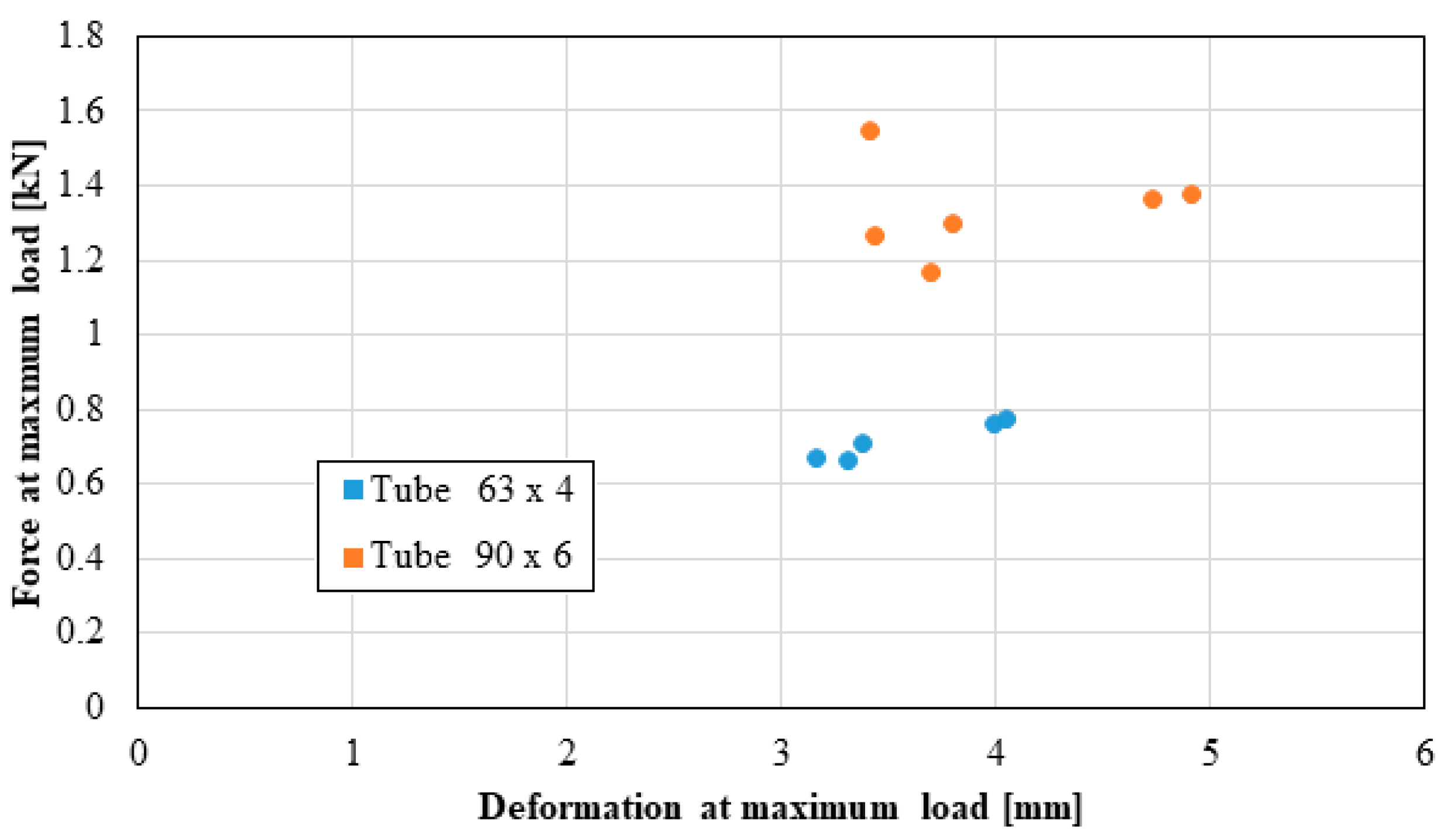
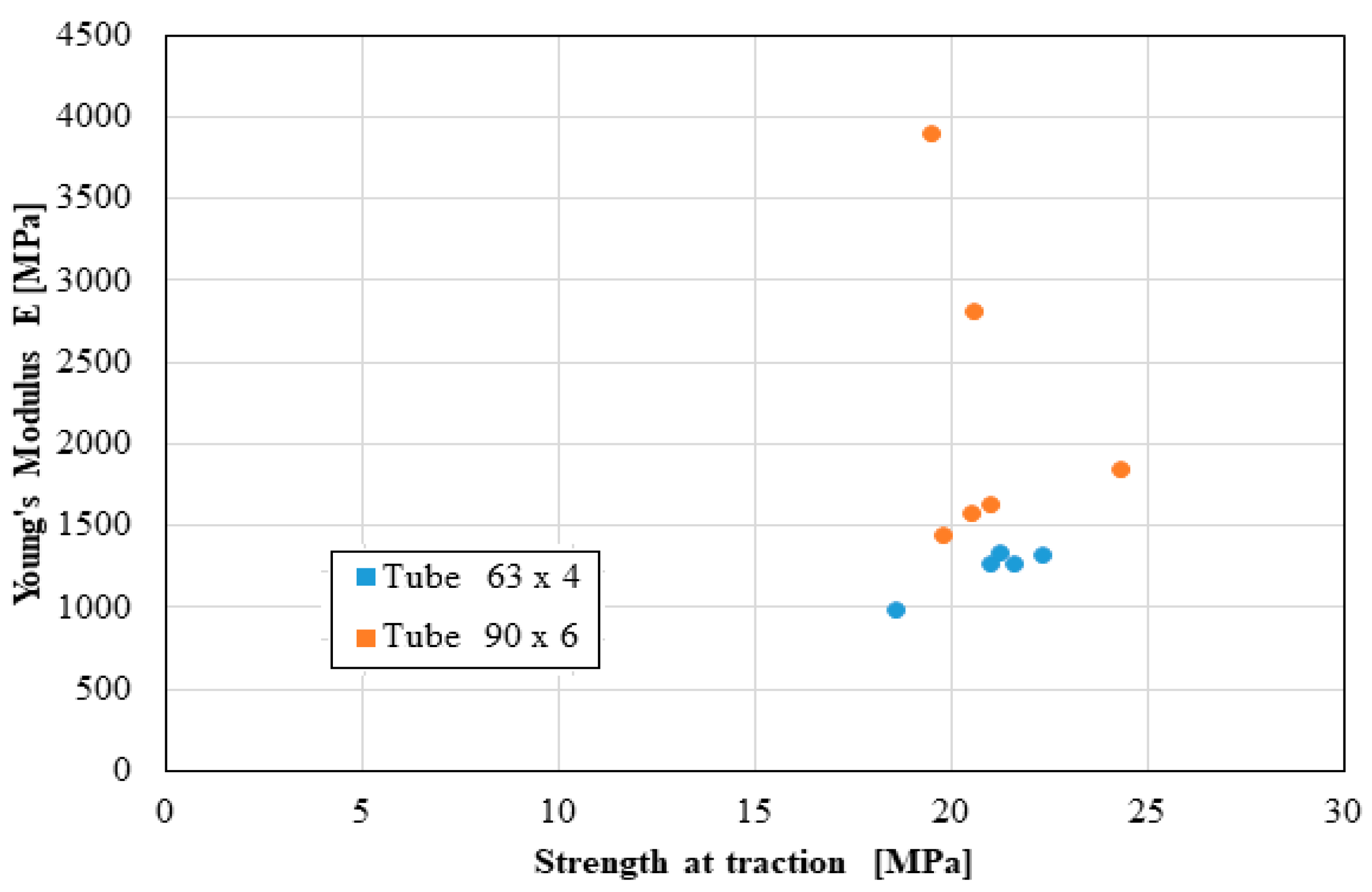
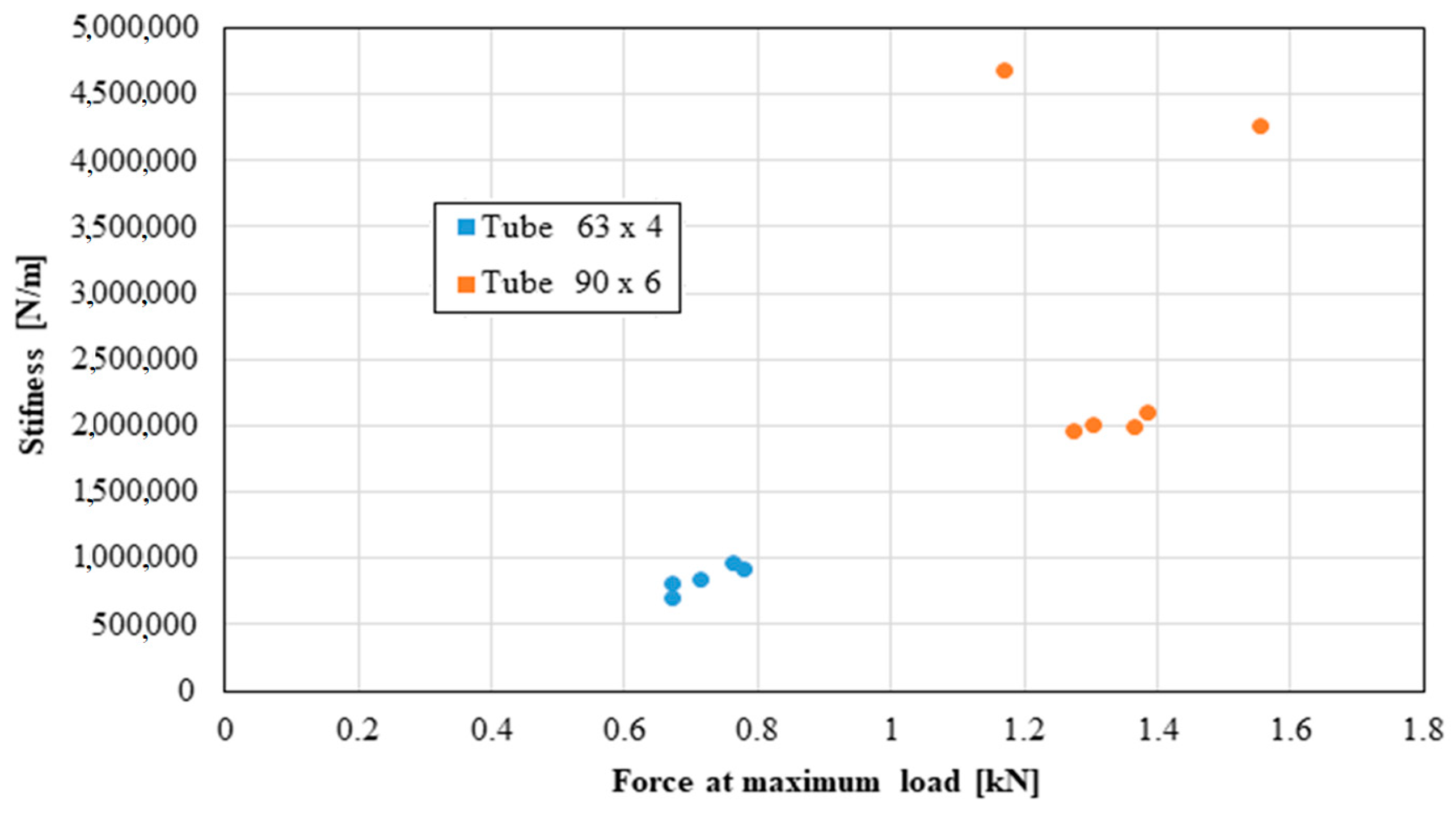
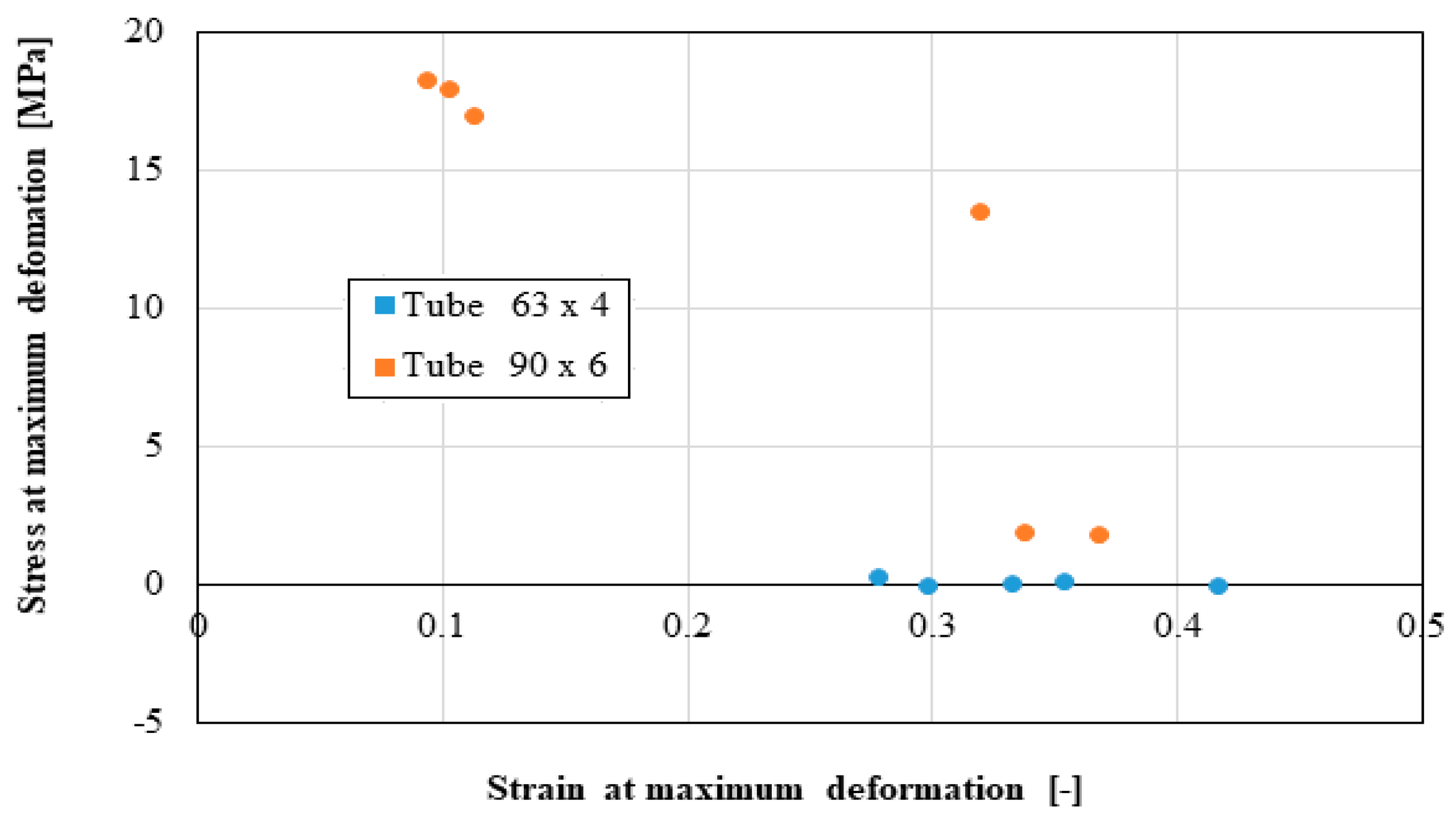
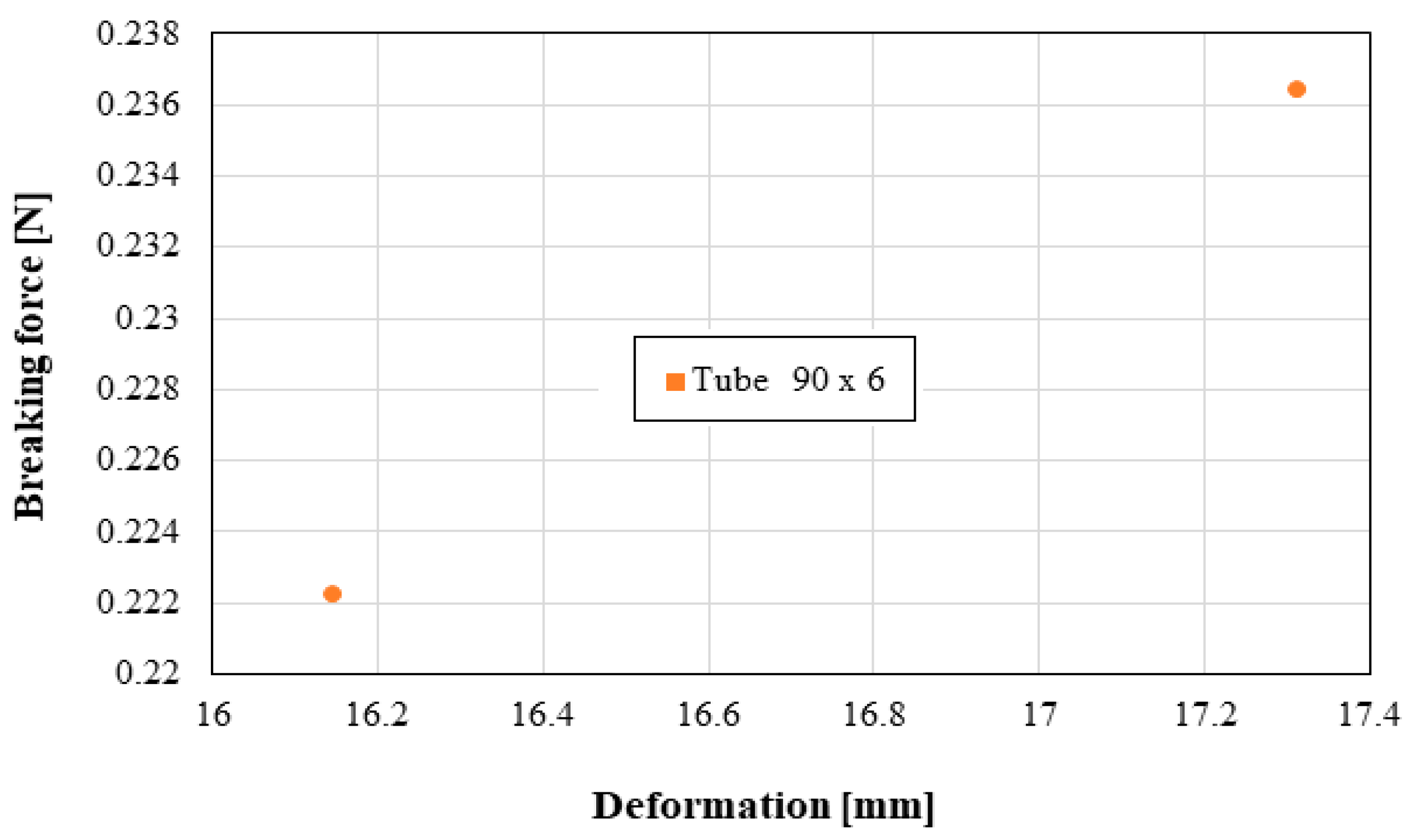
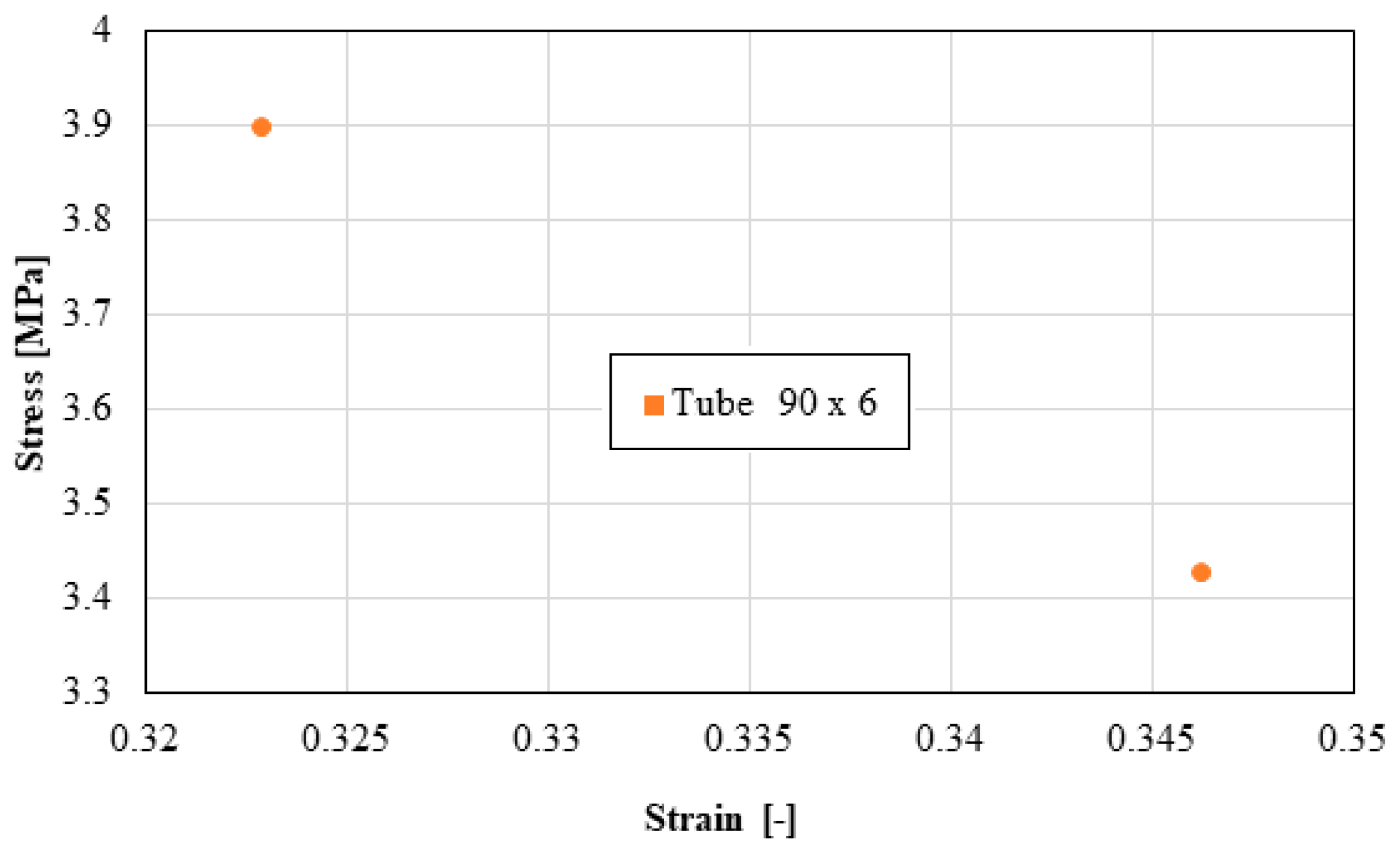
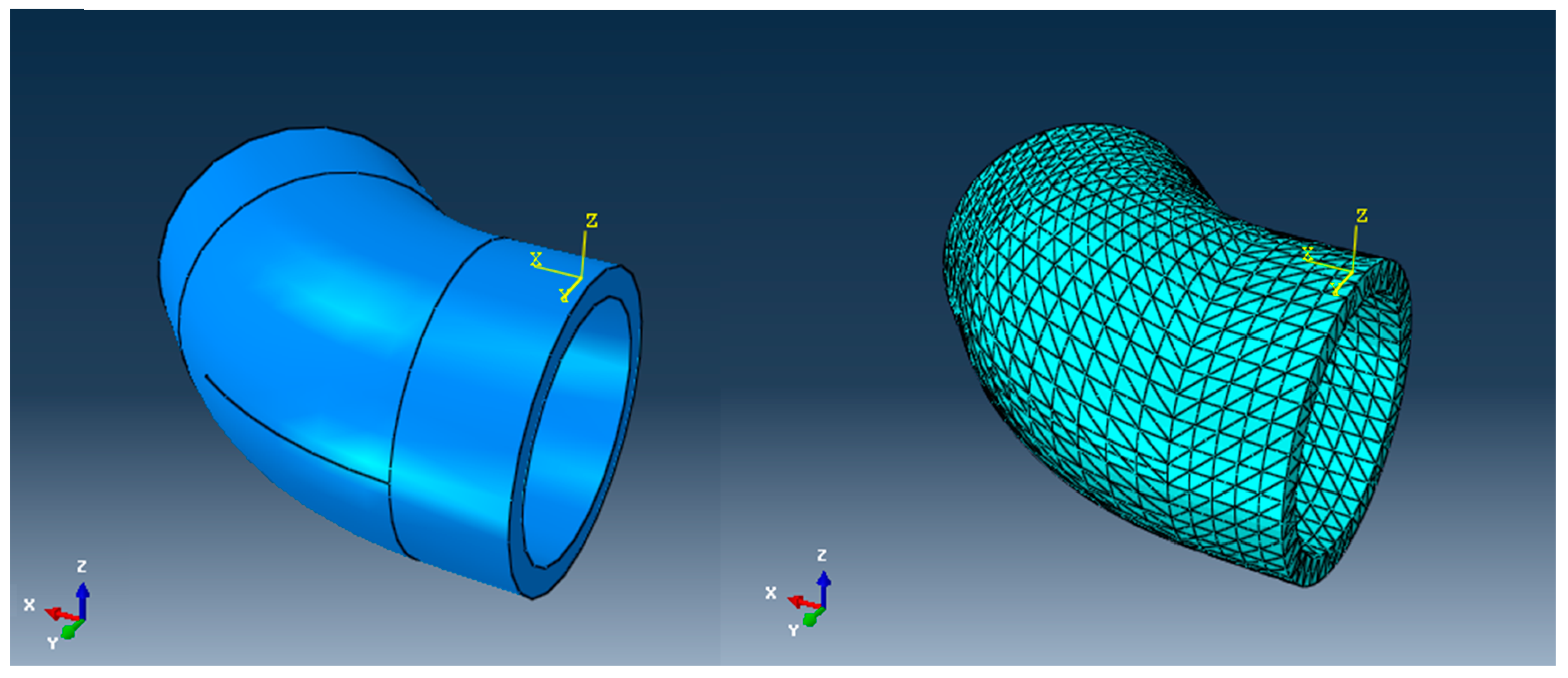
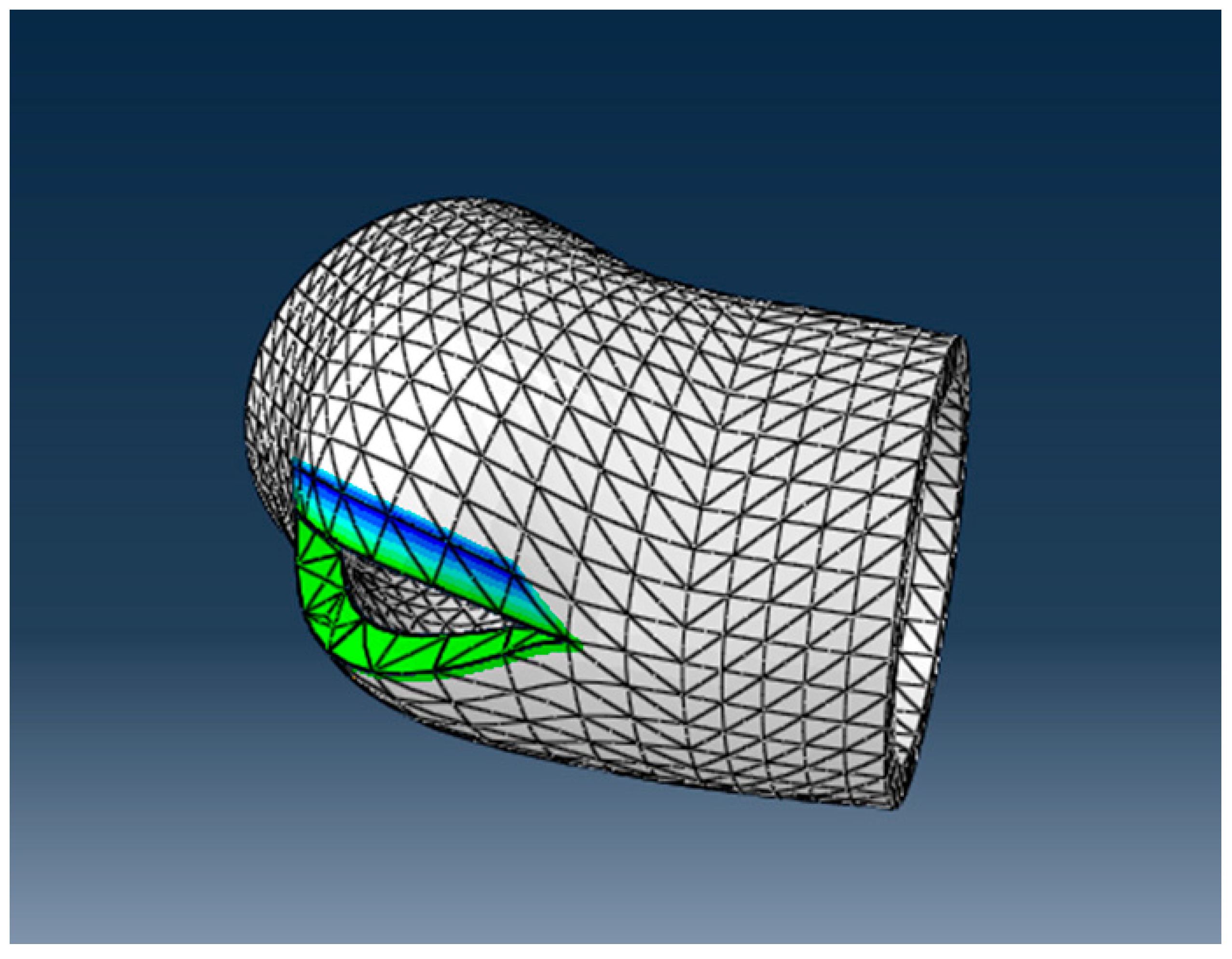

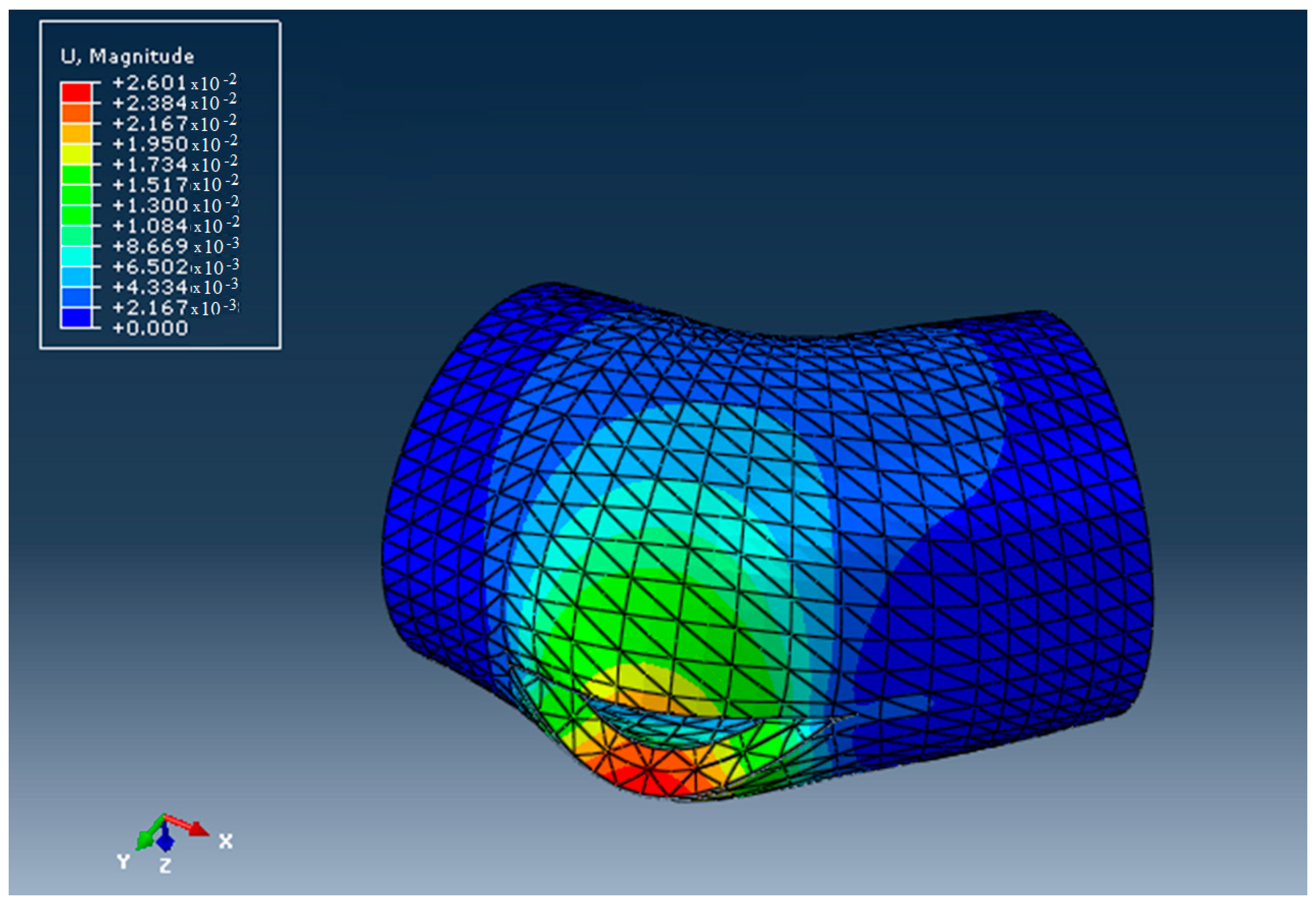

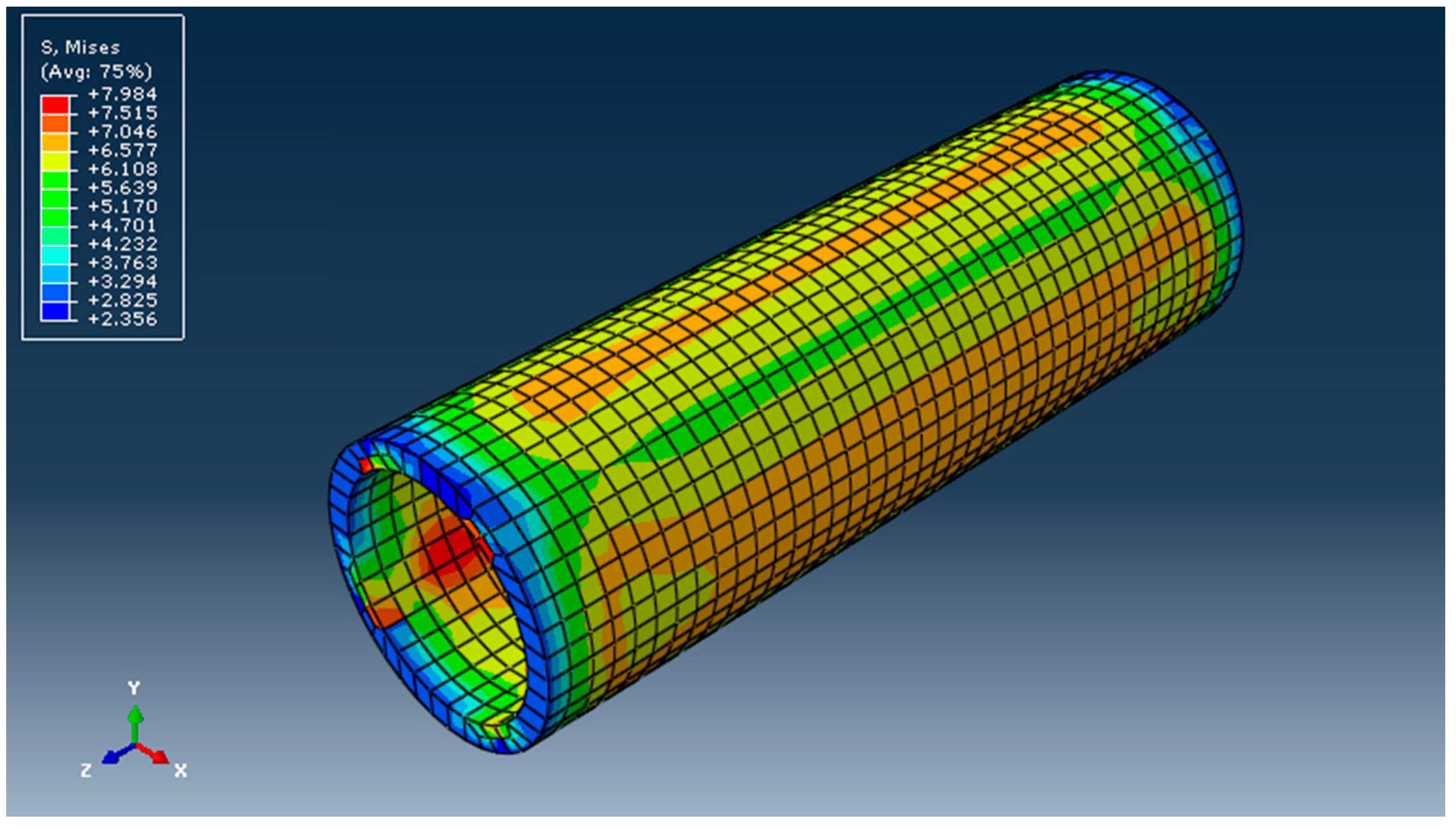
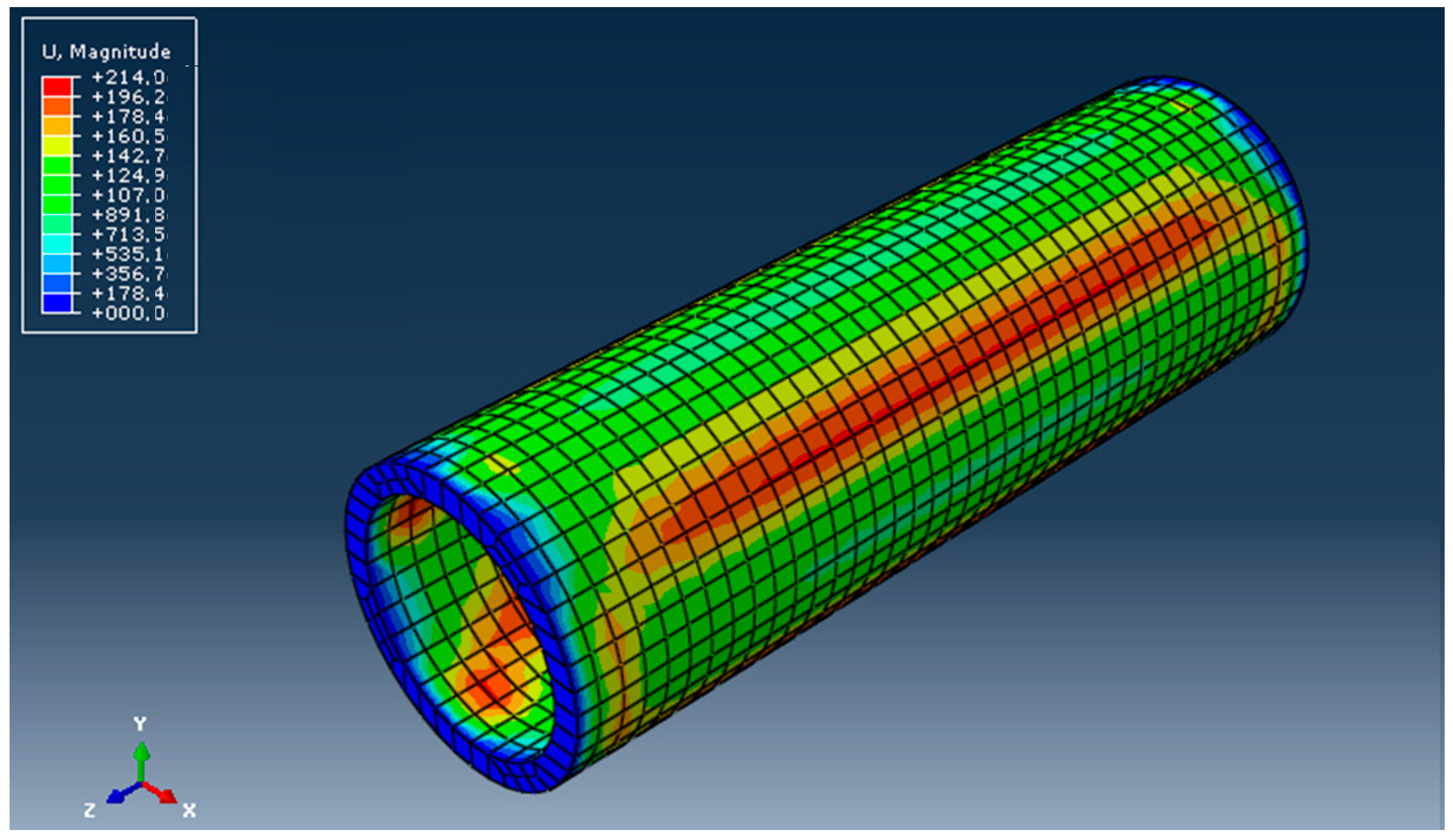
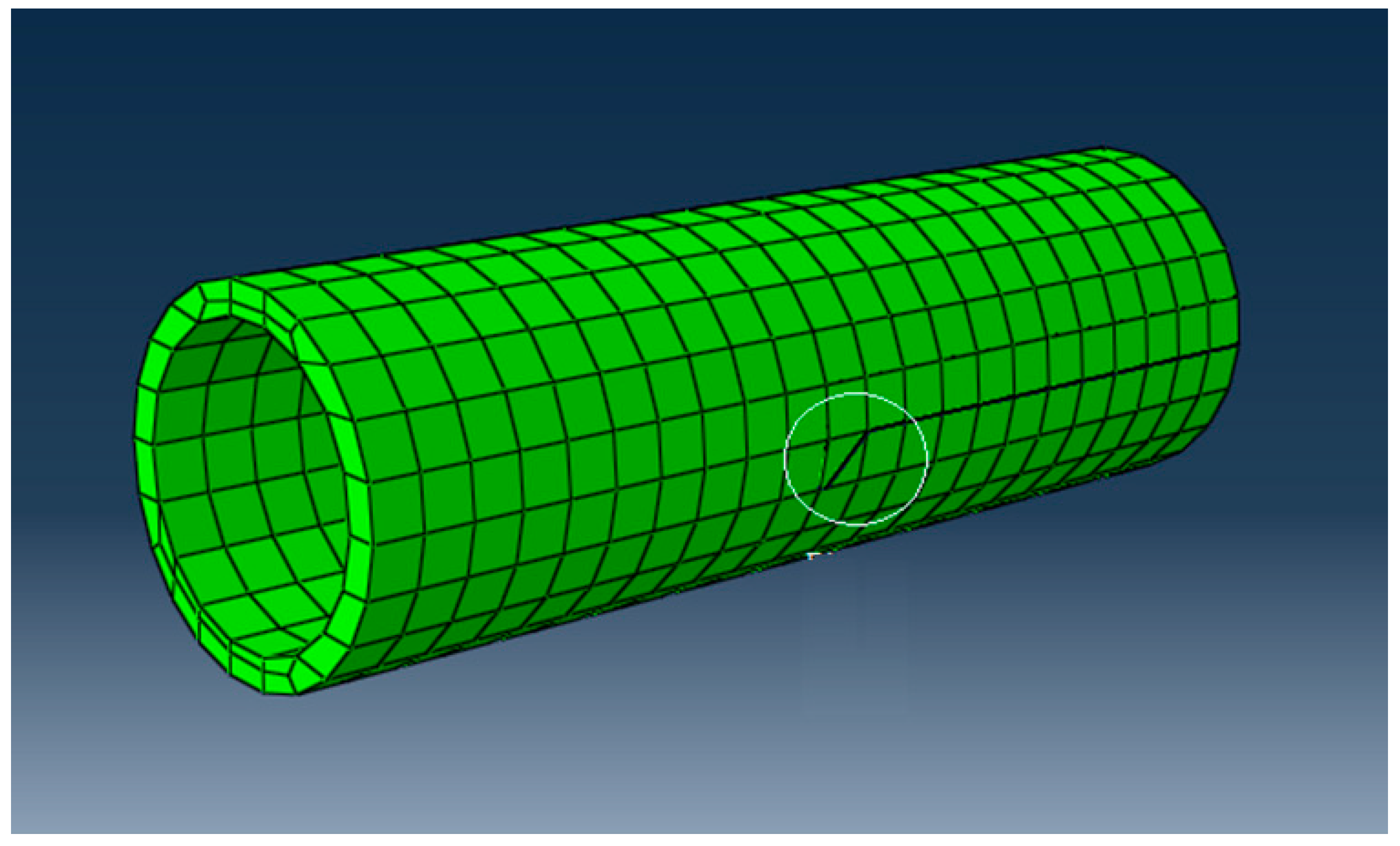
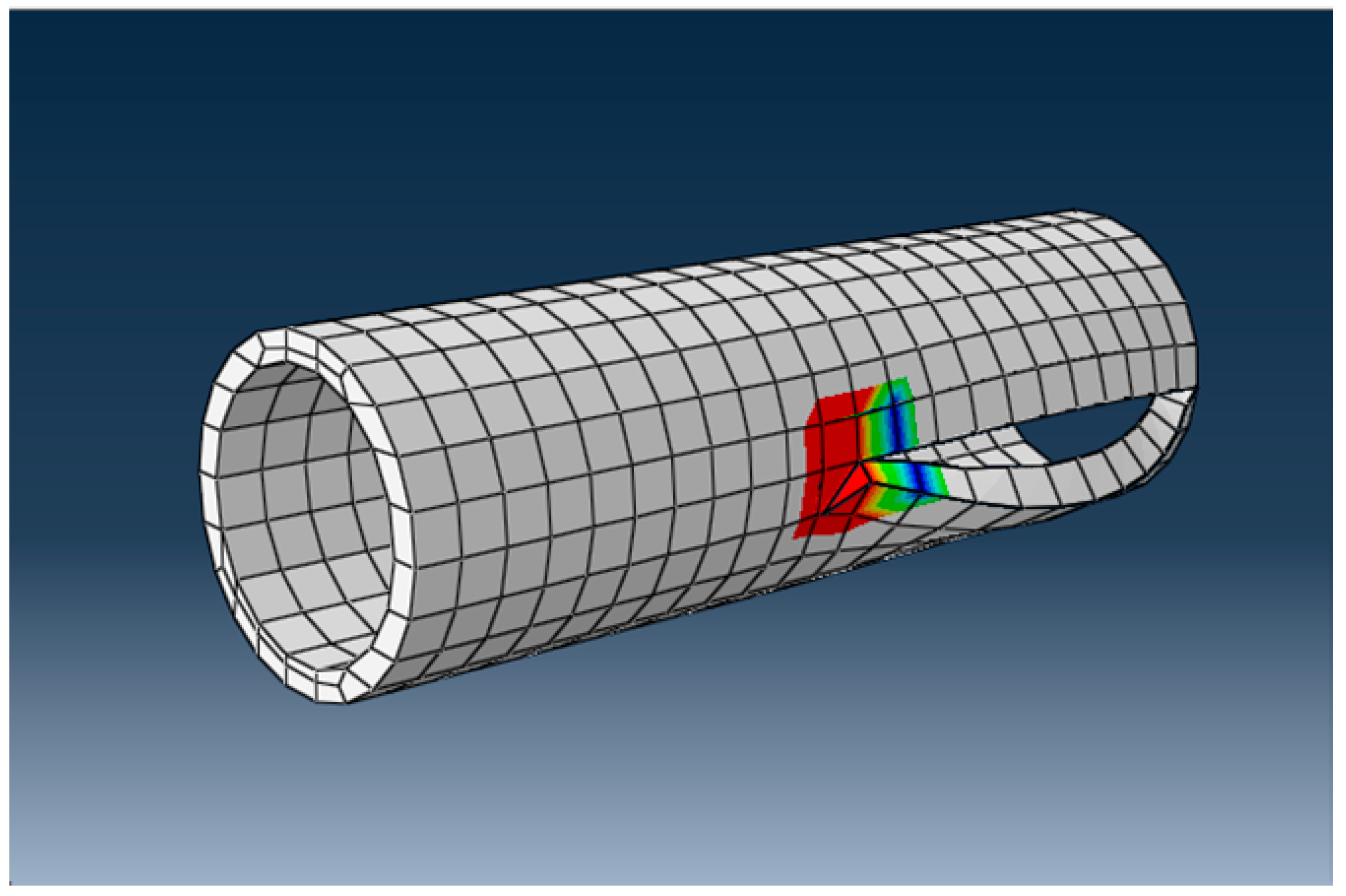
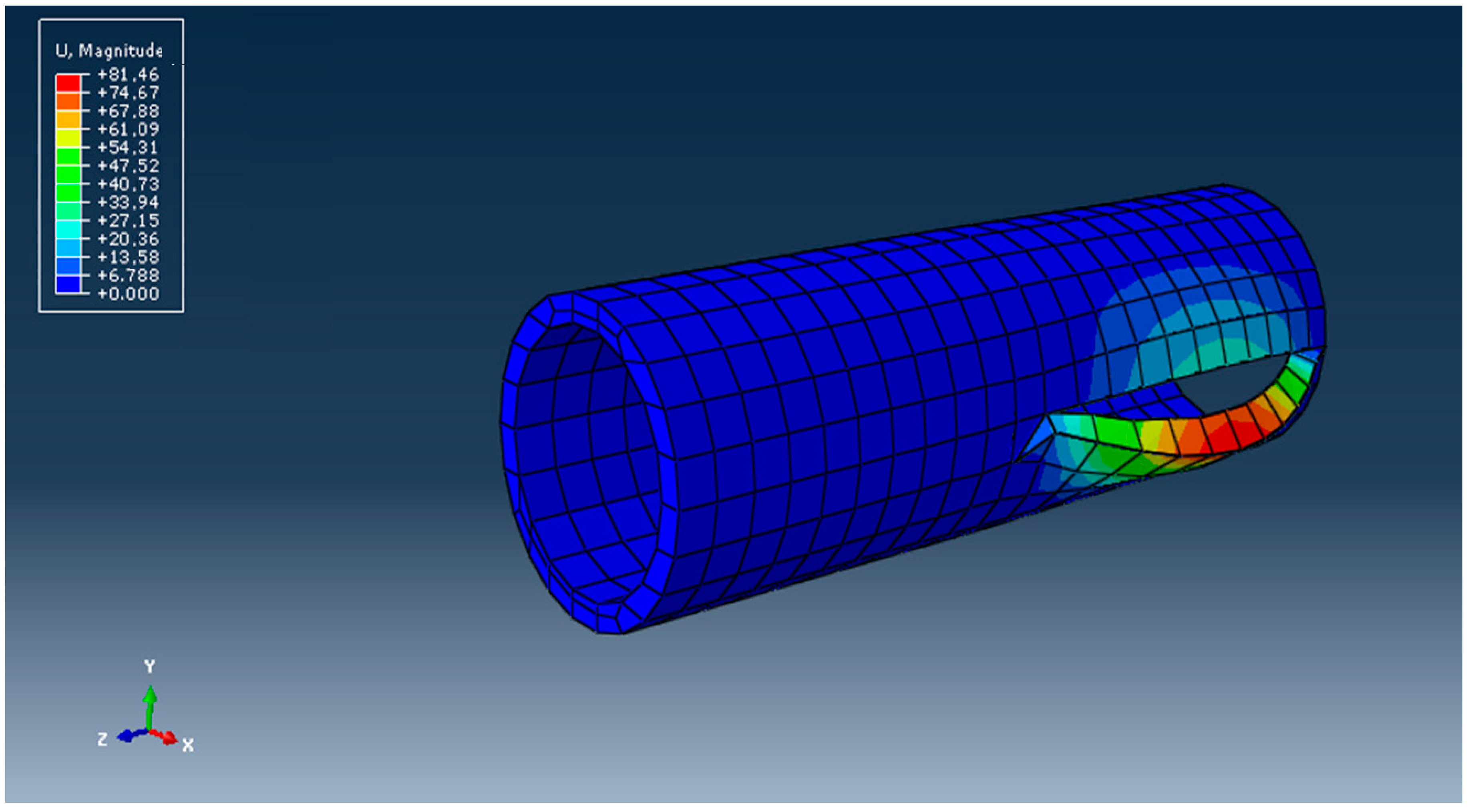
Disclaimer/Publisher’s Note: The statements, opinions and data contained in all publications are solely those of the individual author(s) and contributor(s) and not of MDPI and/or the editor(s). MDPI and/or the editor(s) disclaim responsibility for any injury to people or property resulting from any ideas, methods, instructions or products referred to in the content. |
© 2023 by the authors. Licensee MDPI, Basel, Switzerland. This article is an open access article distributed under the terms and conditions of the Creative Commons Attribution (CC BY) license (https://creativecommons.org/licenses/by/4.0/).
Share and Cite
Teodorescu Draghicescu, H.; Scutaru, M.L.; Vlase, S. Finite-Element-Analysis-Based Study of a Failure Phenomenon in HDPE Pipes. Materials 2023, 16, 6944. https://doi.org/10.3390/ma16216944
Teodorescu Draghicescu H, Scutaru ML, Vlase S. Finite-Element-Analysis-Based Study of a Failure Phenomenon in HDPE Pipes. Materials. 2023; 16(21):6944. https://doi.org/10.3390/ma16216944
Chicago/Turabian StyleTeodorescu Draghicescu, Horatiu, Maria Luminita Scutaru, and Sorin Vlase. 2023. "Finite-Element-Analysis-Based Study of a Failure Phenomenon in HDPE Pipes" Materials 16, no. 21: 6944. https://doi.org/10.3390/ma16216944
APA StyleTeodorescu Draghicescu, H., Scutaru, M. L., & Vlase, S. (2023). Finite-Element-Analysis-Based Study of a Failure Phenomenon in HDPE Pipes. Materials, 16(21), 6944. https://doi.org/10.3390/ma16216944







